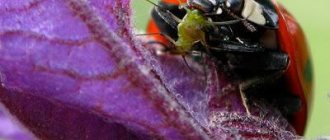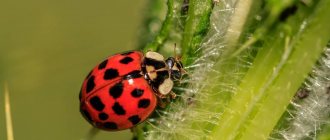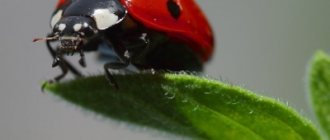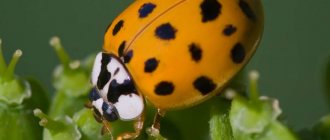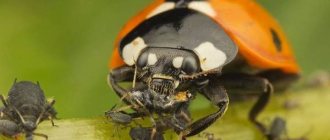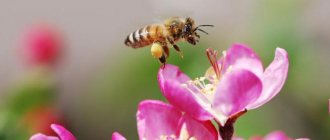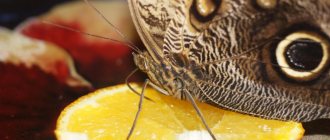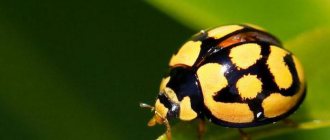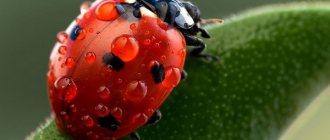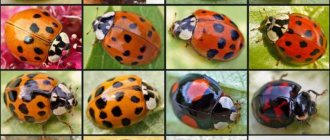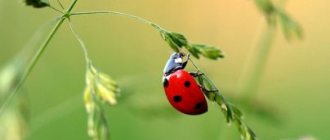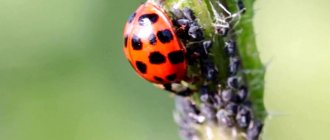- Ladybug: description, structure, characteristics. What does a ladybug look like?
Ladybug, fly to heaven, bring us bread, black and white, but not burnt. (Children's song).
Among all the insects that live in our latitudes, it is the ladybug that enjoys the greatest respect and honor. After all, even the name itself - “ladybug” speaks of a certain divinity of this creature. Why is the ladybug a ladybug? What habits does this insect have, what types of ladybugs are there, where they live, what they eat and many other interesting things about them, read on.
Where does the name ladybug come from?
The ladybug received its unusual name due to its bright red color, which aroused the sympathy of people. So, for example, in Slovenia and the Czech Republic it was called the “sun” (Slunechko), in Germany and Switzerland it is known as the “Virgin Mary’s bug”, in Latin America it is called “St. Anthony’s cow”. What is the origin of the name “ladybug”, there are two versions in this regard, according to the first, it was called “ladybug” for its ability to secrete poisonous milk, which scares off potential predators; our ladybug received the prefix “ladybug” for its meek and peaceful disposition. According to another version, these insects became “God’s” due to their ability to destroy aphids, thereby helping to preserve the crop.
Description, structure, characteristics
According to the biological classification, the ladybug is an arthropod insect that belongs to the Coleoptera and the family of ladybirds.
The size of a ladybug ranges from 4 to 10 mm. The shape of their body is either round or oval-elongated, flat below and very convex above. The body surface of some types of ladybugs is covered with fine hairs. The structure of their body includes a head, a pronotum, a chest consisting of three sections, an abdomen, wings with elytra and three pairs of paws.
The ladybug's head is small (although in some species it may be slightly elongated), it is motionlessly connected to the anterior chest. But the ladybug's eyes are relatively large. The insect's antennae, which consist of 8-11 segments, are highly flexible.
The ladybug's pronotum is convex, has a transverse structure and a notch at the anterior edge. On its surface there are often “signature” spots of different shapes.
Thanks to the presence of three pairs of paws, the ladybug can move quite quickly both on the grass and along plant stems. The abdomen of ladybugs consists of five or six segments, which are covered from below by sternites (segmental semirings).
Despite the fact that ladybugs have two pairs of wings, they fly only with the help of their two hind ones. The front wings, in the process of evolution, were transformed into hard elytra, which serve as protection for the hind wings at the moment when the ladybug is on the ground.
As a means of protection against predators, ladybugs are capable of secreting a kind of poisoned “milk” - cantharidin, a toxic yellow liquid that also has an unpleasant odor. Additionally, the bright colors of the ladybug scare away enemies. The color of the ladybug's protective covers can be not only bright red, but also yellow, black, white with spots of different colors and different configurations. Sometimes the pattern on the pronotum of a cow can indicate its gender.
How do cows find food?
Despite poor eyesight and lack of smell, many species of cows have a certain “hunting strategy.” In search of prey, the cow first runs in a straight line until it stumbles upon the first victim. But, having absorbed it, it begins to describe complex zigzags, knowing that aphids always stay crowded. This significantly improves hunting efficiency. Since the ladybug attacks the aphid only after it has felt it, the aphid may have time to hide from it or push it away with its foot, especially if it is much larger than the predator.
An aphid can roll down from a leaf to the ground, but in this case it needs to be able to climb up again before it dies from exhaustion (which, however, it does not always succeed). Some aphids, when attacking them, douse the body of a ladybug with honeydew, which they secrete from their abdominal tubes. The liquid temporarily paralyzes the predator. Thanks to all these circumstances, the ladybug eats only part of the aphids it detects, and mainly those that are smaller than it. Therefore, young larvae are often forced to make do with eggs or very small aphids.
Many victims know how to hide from cows. Thus, those pads that sit in a crack in the bark or under lichens are inaccessible to predators. As a result, the number of pads, even with an abundance of ladybugs, remains at a fairly high level, which, however, ensures the survival of the predator. Some plants themselves repel ladybugs, and they never visit them, creating good shelters for aphids. But mostly aphids try to protect themselves chemically. Many become poisonous to cows or unsuitable for them. Thus, elderberry aphids (Aphis sambuci), magnolia aphids (Aulacorthum magnoliae) and (Brachycaudus cardui) are not suitable for feeding on the seven-spotted ladybird, but are readily eaten by other species. The vetch aphid (Megoura viciae), on the contrary, attracts this ladybird, but is poisonous to the other two, etc.
Habitats
Ladybugs live over a wide geographical range, on almost all earthly surfaces.
continents with the exception of Antarctica and the polar Arctic regions. As for habitats, some of them prefer to live on plants where a colony of aphids has formed, others choose sedge and reeds along water bodies as a home, while others live in field grasses.
The meaning of cows
Interesting studies on the importance of the eight-spotted ladybird in suppressing the number of aphids were carried out in Czechoslovakia. If in certain, artificially isolated sections the number of ladybugs is high, then the aphids are completely destroyed, but then the ladybugs themselves die from exhaustion. If the concentration of ladybugs is low, they, on the contrary, survive and reproduce normally. But since aphids reproduce much faster, ladybugs are not able to limit their growth. However, in natural conditions the beneficial effect is much higher, because cows in search of food can fly in all directions, often over long distances.
During the season, cows constantly wander. Thus, in Southern Siberia in the spring they are found on a wide variety of plants, but in the summer they concentrate exclusively on nettles. In Central Asia in the fall, after harvesting most crops, ladybugs flock to cotton fields, where they destroy aphids. In Japan, in the summer, some cows switch to feeding on rice leech, a dangerous pest of rice, which brings enormous, invaluable benefits to humans. In Ukraine, in the summer, ladybugs migrate to cereal fields, where their activity is also very useful.
In Central Europe, on the contrary, ladybugs concentrate in the summer where their useful role is much more modest. Sometimes unfavorable environmental conditions cause mass migrations of ladybugs over long distances. During years of severe drought, mass accumulations of ladybirds on the Crimean coast were repeatedly observed. Mass flights have also been described in England, but the cause has not yet been established. There are also wingless species among the cows, but they do not bring any benefit.
Nutrition
All ladybugs are predators, but the predators are very useful for humans, since they eat various harmful parasites: aphids,
ticks, small caterpillars. Sometimes during hunger they will not disdain even the eggs of the Colorado potato beetle. Some types of ladybugs also eat plant foods: mushroom mycelium, plant pollen, leaves and flowers of some trees.
Red Book
The ladybug has long been listed in the Red Book not only of Russia, but of the whole world. The number of individuals has sharply decreased due to the massive destruction of aphids, which led to the disappearance of the main food source of this insect.
This beetle is one of the most ancient insects on earth. The “law” protects it from extermination, since this insect is extremely useful in agriculture.
Sources
- https://www.poznavayka.org/zoologiya/bozhya-korovka/
- https://animaljournal.ru/article/bojya_korovka
- https://konohovo.ru/stati/chem-pitaetsya-bozhya-korovka-v-prirode.html
- https://protarakanov.ru/bozhya-korovka.html
- https://posevsado.ru/chem-pitaetsja-bozhja-korovka-v-prirode.html
- https://WikiParazit.ru/zhuki/bozhya-korovka-vidy-opisanie.html
- https://aquarium-fish-home.ru/nasekomye/bozhya-korovka-nasekomoe-vidypitanierazmnozheniefotovragiopisanie/.html
- https://zhivotnyeplanety.ru/bozhya-korovka/
- https://2516826.ru/kleshchi/kak-uhazhivat-za-bozhej-korovkoj.html
- https://TaraKlop.ru/zhuki/chto-edyat-bozhi-korovki/
- https://protarakanov.ru/chem-pitayutsya-bozhi-korovki.html
- https://www.m-sokolov.ru/2016/07/07/coccinellidae/
- https://chtoedyat.ru/chto-edyat-bozhi-korovki/
- https://gkd.ru/444094a-chto-est-bojya-korovka-mesto-obitaniya-pitanie-razmnojenie
- https://NatWorld.info/zhivotnye/fakty-o-bozhih-korovkah
- https://bioros.net/nasekomye/bozh-ya-korovka-opisanie-vidy-chem-pitaetsya-interesnye-fakty.html
[collapse]
Lifestyle
Regardless of the species, all ladybugs are not gregarious insects, but ardent individualists leading a separate lifestyle. They gather together only during their mating season for procreation, as well as for flights to warmer regions and wintering grounds. Since these insects love warmth, the species that live in our temperate latitudes gather in large flocks before the onset of winter cold and fly away like birds for the winter in places with a warmer climate.
Although there are sedentary individuals who also gather together in some secluded place during the winter cold, usually these are collapsed stones, fallen bark and tree foliage. With the onset of spring and warmth, they scatter across the meadows and grasses again.
How do they winter
The ladybug doesn't like the cold. Of the more than 4 thousand species of ladybirds known in the world, barely a tenth is found in the Holarctic, and here, too, most species are characteristic of the subtropics. This is enough to talk about the weak winter hardiness of insects. Many animals have known aggregations for wintering, but the record in the number of these aggregations undoubtedly belongs to cows, in which, as mentioned above, aggregations of up to 40 million individuals are known (USA). These accumulations even serve as food for bears. In winter aggregations, in which the cows are pressed tightly together, the temperature is several degrees higher than in the environment. Two types of clusters have been described—hypsotactic and climatological.
The first form on the tops of mountains or hills, usually under heaps of stones and in rock cracks, in dry and windy places. In the Himalayas, such accumulations (for the seven-spotted ladybird) were found up to an altitude of 4500 m above sea level. m., in Transcaucasia, Central Asia and Altai they are usually located at altitudes of about 2-3 thousand m. In Italy they are rarely located above a thousand meters. It is in this type of aggregation that ladybugs can be very numerous. Climatological accumulations form in forests, often around old trees, on trunks, under their bark or in cracks, hollows, etc., sometimes under stones, and stations with high humidity are often selected. These clusters are never very large.
It has been noted that the same species, for example the same seven-spotted ladybird, can form aggregations of both types or overwinter on the forest floor in small batches, so population polymorphism has an effect here too. Accumulations, especially gypsotactic ones, are associated with migrations, often significant, and usually form at the same points from year to year, with the migration to wintering taking place over several days, and the dispersion in the spring is extended. Winter aggregations are typical only for species that feed on aphids. The same species that feed on coccids or mites, as well as herbivores, usually overwinter alone or in small groups in the same place where they feed. The biological meaning of the clusters has caused much debate among entomologists.
Types, photos and names
Zoologists identify 4,000 different species of ladybugs, divided into 7 subfamilies. We will describe the most interesting among them.
Two-spot ladybird
This is a beetle with a body length of up to 5 mm, with a dark red body and two black dots (hence the name).
Seven-spotted ladybird
It is this type of ladybug that is most common in Europe. Its size is 7-8 mm. Its elytra are painted red, there are three black spots on the sides, and the seventh is located near the head of the insect.
Twelve-spotted ladybug
This ladybug has a length of 6 mm, a bright pink or red color, and, accordingly, 12 black spots on the elytra.
Thirteen-spotted ladybird
This type of ladybug has as many as 13 spots against the background of red-brown elytra; some of its spots can merge with each other.
Asian ladybug
This ladybird is up to 7 mm long and is divided into two subspecies. One of them has a yellow wing cover with black spots, both large and small. The second subspecies is characterized by black coloration of the elytra, on which red-orange spots are visible.
Ocellated ladybird
This is a very large representative of the ladybird family, reaching up to 10 mm in length. It has red or yellow elytra and black spots surrounded by lighter rims.
Pointless ladybug
This is a very rare species; its characteristic feature is the absence of signature spots. Also, the red or brown body of the pointless ladybug is covered with small fibers.
Blue ladybug
This is another unusual member of the ladybug family, having a characteristic blue color. Such insects live exclusively in Australia.
Reproduction and development stages
Ladybugs reach sexual maturity, depending on the species, at 3-6 months of life. Their mating season begins in the spring. The male finds his chosen one by the characteristic smell that she emits during that period. A short time after mating, the female ladybug lays eggs, and often acts very wisely, laying them near aphid colonies in order to immediately provide future offspring with food.
Ladybug eggs are attached to the underside of the leaves; they are oval in shape with slightly tapered ends. There are up to 400 eggs in one clutch. Unfortunately, the females themselves die soon after laying eggs.
After 1-2 weeks, variegated ladybug larvae emerge from the eggs. They have an oval or flat shape. The surface of the larva's body is often covered with thin bristles or hairs. In the first days of their lives, they eat the shell of the egg from which they hatched, then neighboring eggs without or even with embryos (yes, ladybug larvae can be cannibals). Gradually gaining strength, they begin to eat the aphid colony.
The future ladybug remains in the larval state for 4-7 weeks, after which the pupation stage begins. The pupa is attached to a leaf of the plant and in this position, in the cocoon, spends 7-10 days; it is during this period that all body parts characteristic of a cow are formed. After this period, a fully formed adult appears.
Reproduction
Discussing the topic “When and how a ladybug reproduces,” it is worth noting that this process occurs from the beginning of March, and one insect mating sometimes lasts up to 9 hours in a row. The female can lay from five to three hundred yellow eggs that have an elongated shape. For laying, she chooses places with a large concentration of aphids, since the number of offspring depends on this.
A week later, the eggs hatch into larvae with well-developed jaws. They are very voracious and eat huge amounts of aphids. The larvae themselves have a disgusting taste, so almost no one hunts them. After another ten to fifteen days, a ladybug pupa emerges from the larva, which attaches to the plant leaves using the remains of the exoskeleton. After another two weeks, during which all the characteristic parts of the body are formed, it turns into a fully formed adult.
A young insect can be recognized by its pale color and lack of pattern. Over time, the back of the ladybug acquires a rich shade, and a corresponding pattern appears on it. In general, the duration of the full cycle of development and transformation is from four to seven weeks.
Benefits and harms
The benefits of the ladybug, especially in our latitudes, are undeniable; the principle “the enemy of my enemy is my friend” works here. Ladybugs, by eating various insect pests, provide a great service to agricultural lands. Sometimes they are even specially bred in special places and then sprayed over fields and plantations infested with pests.
But among them there are also herbivorous species, most of them live in tropical areas, which can also harm agricultural crops.
Interesting Facts
Other signs
Under no circumstances should you step on the messengers of good forces, which include ladybugs, otherwise the person will face failure, and if this spotted insect is killed by accident, you must definitely ask him for forgiveness and do some good deed. There are many other beliefs, regarding these cute insects:
- Meeting a flying ladybug is considered a significant event only if it ends up in an apartment or sits on a person - other options, including outside the window, do not mean anything important.
- One of the few bad omens associated with this cute insect is to see it in a web or in trouble, which could mean the machinations of enemies. To protect yourself from negativity, you should get it out as soon as possible.
- Bugs and butterflies that live in the cemetery are considered to be the embodiment of the souls of the dead, and if a person notices a spotted insect among the graves, there is no need to worry about the future - one of the deceased relatives provides serious support.
- Not everyone is able to see how a spotted insect washes itself or cleans its wings, so such a sight portends special luck.
- A ladybug can bite very rarely, since their jaws are designed exclusively for destroying harmful insects, but if this does happen, you need to pay special attention to the event. Perhaps the baby wants to warn about some troubles in the future or about the machinations of enemies. Otherwise, you should not be afraid of the bites of these bugs - they are practically painless and do not pose any harm to health.
- A ladybug can be an excellent talisman that will protect you from troubles and bring good luck. The only prohibition is not to use a dead insect as an amulet, otherwise the effect will be the opposite.
Video
And finally, an interesting video about ladybugs.
Author: Pavel Chaika, editor-in-chief of Poznavaika magazine
When writing the article, I tried to make it as interesting, useful and high-quality as possible. I would be grateful for any feedback and constructive criticism in the form of comments on the article. You can also write your wish/question/suggestion to my email [email protected] or Facebook, with respect, the author.
Author page
